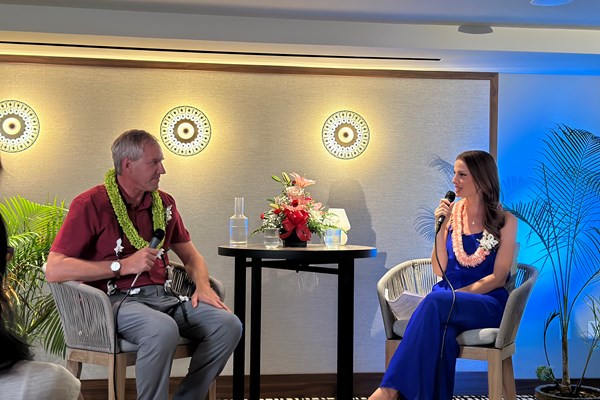California energy leader urges Hawai‘i to seize state-level power in clean energy transition
Aug 26, 2025

California Energy Commission Chair David Hochschild delivered a message about how the Golden State is proving that bold climate action and economic growth can go hand in hand. He said Hawai‘i can do the same.
This was the focus of his keynote talk, “Pacific Rising: How California and Hawaiʻi can lead the clean energy revolution,” on Aug. 7. The event was part of the University of Hawaii’s Better Tomorrow Speaker Series, sponsored by Climate Hawai‘i with support from AC Hotel Honolulu, Hawai‘i State Energy Office, UH School of Ocean and Earth Science and Technology, the Scholars Strategy Network, and Ulupono Initiative.
Hochschild leads an $8.5 billion agency that directs energy policy for 40 million California residents. He is a graduate of Swarthmore and the Harvard Kennedy School; brings more than 20 years of experience in energy transformation; and has been honored by the Sierra Club, American Lung Association, and U.S. Department of Energy. In 2024, he was named the American Energy Society’s Person of the Year.
“Most of the power and most of the policies that really matter for the energy transition are still made at the state level,” Hochschild told the audience. “We’ve got to lean into that power and be bold.”
California’s clean electricity share has reached 70%, with the state actually reaching 100% clean energy for at least one hour and up to seven hours on 93% of days in 2025. Electric vehicle adoption continues at 1,300 new registrations daily, and California now has more EV charging stations (180,000) than gas stations (120,000). Since Governor Gavin Newsom took office, the state has deployed 27 gigawatts of clean energy and storage capacity, including 16 gigawatts of storage alone.
Some claimed that climate policies would harm the economy, but California has risen from the world’s 10th largest economy to fourth. He also reported that, nationwide, 96% of new electricity capacity added in 2024 came from clean energy sources.
Hochschild noted the dramatic drop in solar costs — from $5 per watt to $0.16 — and highlighted the state’s equity focus: 60% of EV charging investments and 75% of clean energy research go to low-income and disadvantaged communities, along with $130 million for 35 tribal energy sovereignty projects.
Despite federal policy uncertainty, Hochschild expressed “inexplicable optimism” for the clean energy future. “Sometimes in life, the moments that we feel most powerless, we’re actually most powerful,” he said.
Speaking to a question about Hawai‘i’s consideration of liquefied natural gas (LNG), he said California avoids new fossil fuel infrastructure because clean solutions like battery storage are faster to deploy and keep more energy dollars in-state.
Clean energy advocates have raised concerns about LNG assumptions specific to Hawai‘i’s development track record. Many point out that Hawai‘i lags in its ability to implement development (or new technology) quickly. There is also concern about retiring or transitioning old infrastructure once new options are built. Advocates say those two factors would need to be addressed for LNG investments to make any sense as a bridge technology in a state committed to 100% renewable energy by 2045.
Hochschild’s talk was moderated by Living808 and Empowered Hawai‘i host Kelly Simek. The event drew energy leaders, policymakers and advocates eager to hear how California has accelerated its clean energy transition while becoming the world’s fourth-largest economy.

